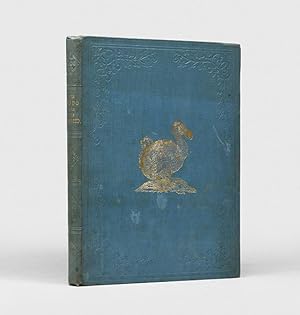strickland hugh edwin alexander gordon (1 Ergebnisse)
Produktart
- Alle Produktarten
- Bücher (1)
- Magazine & Zeitschriften
- Comics
- Noten
- Kunst, Grafik & Poster
- Fotografien
- Karten
-
Manuskripte &
Papierantiquitäten
Zustand
- Alle
- Neu
- Antiquarisch/Gebraucht
Einband
- alle Einbände
- Hardcover
- Softcover
Weitere Eigenschaften
- Erstausgabe
- Signiert
- Schutzumschlag
- Angebotsfoto
Land des Verkäufers
Verkäuferbewertung
-
The Dodo and its Kindred: or the history, affinities, and osteology of the dodo, solitaire, and other extinct birds of the islands Mauritius, Rodriguez and Bourbon.
Verlag: London: Reeve, Benham, and Reeve, 1848, 1848
Anbieter: Peter Harrington. ABA/ ILAB., London, Vereinigtes Königreich
Erstausgabe
First edition of this finely illustrated work. This copy has a superb provenance: with the bookplate of naturalist Sir William Jardine and his daughter Catherine Dorcas Maule Strickland, the author's wife. Strickland provides a comprehensive history and external description of the dodo, while the physician Melville analyzed the anatomy. A sparkling copy, rarely found in such collectible condition. With this important rediscovery of the extinct and largely forgotten dodo, Strickland set out to prove anthropogenic species loss and declared that "these singular birds. furnish the first clearly attested instances of extinction of organic species through human agency" (p. 5). To produce this monograph and support his claim about the reality of the bird Strickland gathered "historical, pictorial and anatomical evidence" (Barrow, p. 54). He reviewed fifteen original and independent accounts of the bird and went on to analyse five oil paintings of the species. Finally, he "turned to a discussion of the bird's meager surviving fragments: a foot in the British Museum, a cranium in the Gottorf Museum in Copenhagen, and a desiccated head and foot in the Ashmolean Museum in Oxford. The latter two fragments were all that remained of a once complete specimen that had decayed over the course of a century and barely escaped destruction during a bout of spring cleaning at the museum" (ibid.). The Dodo and its Kindred shows the "present state of the knowledge of the Didinae, in order to remove the many erroneous statements which are current, and to restore the lost organisms to their rank in the natural system" (publisher's catalogue). In Victorian fiction the dodo emerges most famously in Alice in Wonderland (1865), employed by Carroll as a caricature of himself. Hugh Edwin Strickland (1811 1853) was a natural historian, geologist, ornithologist, and member of the British Association for the Advancement of Science committee alongside Charles Darwin and Richard Owen. Strickland found his wife, Catherine Dorcas Maule (1825 1888), through his interest in natural history. He met "Sir William Jardine, bt, at the British Association for the Advancement of Science meeting at Glasgow in 1840, having previously corresponded with him on ornithological topics. On 23 July 1845 he married Jardine's second daughter, Catherine Dorcas Maule. She assisted both her father and her husband with drawings of birds, some reproduced anastatically in Jardine's Contributions to Ornithology (1848 53). Stricklandwas fatally wounded when struck by a train while geologizing near Clarborough Tunnel in 1853" (ODNB). Prince Albert, Sir William Jardine, the ornithologist John Gould, natural history artist Prideaux John Selby, engraver William Home Lizars, and cartographer John Arrowsmith are found in the small list of 124 subscribers. Fine Bird Books, p. 145; Nissen IVB 900. Mark V. Barrow, Nature's Ghosts: Confronting Extinction from the Age of Jefferson to the Age of Ecology, 2011. Folio. Original light blue cloth, spine lettered in gilt, gilt stamp of dodo on front cover and Rodrigues solitaire on back cover, spine and covers elaborately stamped in blind, yellow surface-paper endpapers, top edge gilt. Housed in a dark blue cloth flat-back box by the Chelsea Bindery. With hand-coloured lithographed frontispiece of a dodo by Vincent Brooks after Roelandt Savery, heightened with gum arabic, and 17 lithographed and anastatically-printed plates, including on folding and another hand-coloured, wood-engraved illustrations in the text. A few minor marks to covers, scattered foxing, text block cracked between pp. 50-1. A splendid copy.


